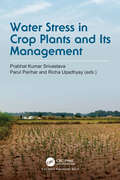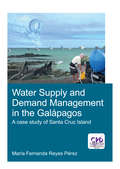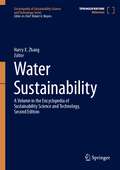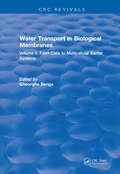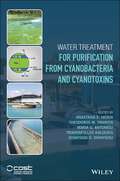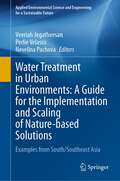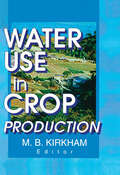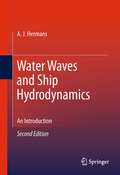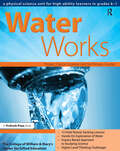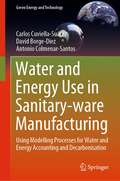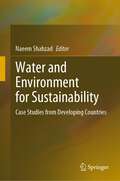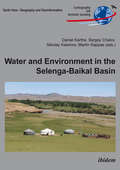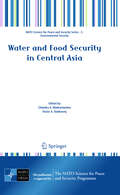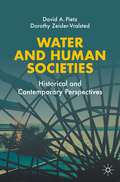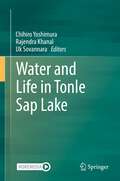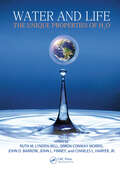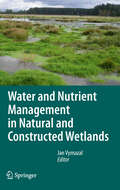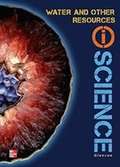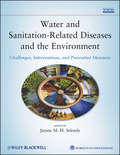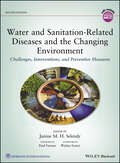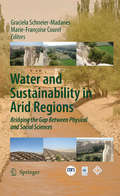- Table View
- List View
Water Stress in Crop Plants and Its Management
by Parul Parihar Prabhat Kumar Srivastava Richa UpadhyayThe book provides an overview of water stress in plants and alterations in the physiology, morphology, anatomy, and molecular mechanism due to water stress. The induction of water stress hormones and the up-regulating genes synthesizing them is also the major thrust of the book. It also deals with the water and nutrient uptake, alteration in water relations, transpiration and stomatal conductance, and hence in the amount of photosynthesis vis-à-vis water stress. It compiles recent studies on redox regulation, antioxidative systems, nitrogen metabolism and phytohormonal regulation in crop plants during water stress. Different strategies to manage water stress, viz. by using different osmolytes, proteins, hormones and growth regulators, antioxidants, plant extracts, nitric oxide donors, macro and micro mineral nutrients, and the use of silicon have been discussed. The viability of different biotechnological tools to make crop plants less water-demanding, the use of vetiver grass and the insertion of mycorrhiza in water-stressed crop plants have been explored. An exhaustive review of recent literature encompassing genomic, proteomic, transcriptomic, ionomics, and metabolomics approaches to have a better understanding of water stress is the prominent feature of the present book. It discusses major signaling molecules involved in water-stressed environments as well as the crosstalk with other minerals, phytohormones etc. Not least, the book endeavors to illustrate different water conservation methods to achieve sustainable agriculture. The book is a comprehensive compilation of work to date on water stress and its management techniques and this will bridge the missing gap between the research from the past to the current time.
Water Supply and Demand Management in the Galápagos: A Case Study of Santa Cruz Island
by Maria Fernanda Reyes PerezWater resources in tourist islands have been severely threatened, especially in the Galápagos Islands, where the increased local population has generated attractive income from the tourist services. In addition, the data regarding water supply and demand are scarce. This study investigates water supply and demand in Santa Cruz, the most populated island of Galápagos. The research encompasses a thorough assessment of the water supply crisis, as well as the quantification of water demand from different categories (domestic, tourist, restaurants and laundries) through surveys, in the absence of water metering. Also, specific water demand was assessed by installing 18 water meters. The results yield a wide range of water consumption, questioning the current assumption of water scarcity. Furthermore, a prognosis of water supply and demand was carried out, and also several intervention strategies were proposed such as rainwater harvesting, greywater recycling, leakage reduction, water meter installation, water demand reduction, as well as seawater desalination to cope with the future population growth. Due to the fragility of the ecosystem, these strategies were assessed through a Multi-Criteria Decision Analysis, considering environmental, technical, economic and social aspects, as well as relevant stakeholders’ perspectives. finally, the water supply network of Puerto Ayora was evaluated in order to understand the need of the current intermittent supply regime. A methodology was developed to estimate the overflow of the domestic roof tanks (a common incidence amongst local population). The results question the practicality of individual household storage. The final results show that the current situation in terms of the lack of water quantity may not be real, as it has been thought for the last decades. The water issues refer more importantly to the water quality, as well as to the lack of proper water management practices.
Water Sustainability (Encyclopedia of Sustainability Science and Technology Series)
by Harry X. ZhangThis newly updated Water Sustainability volume of the Encyclopedia of Sustainability Science and Technology (ESST) takes a holistic view of full water cycle and integrates the water themes into sustainability science and technology.With the increasing pressures of population growth, water scarcity, flooding, water pollution, climate impacts and competition of water uses among municipal, agricultural, industrial sectors and ecosystem, there is a growing trend in promoting Integrated Water Management and “One Water” concept worldwide. This reference volume covers multi-disciplinary sustainability topics from the perspective of integrated water management, which includes drinking water, wastewater, stormwater, reclaimed water and groundwater. It also spans cross-cutting themes of the water-energy-food nexus, showing how all of these sectors are inextricably linked.Water Sustainability is a comprehensive resource for a broad audience of scientists and engineers, researchers and practitioners, and decision makers whose objective is to advance sustainable water management.
Water Transport and Biological Membranes: Volume 2
by Gheorghe BengaThe main purpose of this book is to provide in-depth presentation of physical techniques for measuring water transport and their applications to a variety of biological membranes, from model membrane systems to cell membranes, and then from isolated cells to multicellular barrier systems, such as epithelia or even whole organisms. This survey of water transport in such a broad range of membrane systems will hopefully contribute to understanding of the structure-function relationships and molecular mechanisms of water permeation. Moreover, the description of various techniques, together with a review of literature will enable the readers to assess whether a technique would be useful in helping to solve his or her particular problem of research and will also expand their competence in these techniques. The book consists of two volumes.
Water Treatment for Purification from Cyanobacteria and Cyanotoxins
by Dionysios D. Dionysiou Triantafyllos Kaloudis Anastasia E. Hiskia Maria G. Antoniou Theodoros M. TriantisProvides a comprehensive overview of key methods for treating water tainted by cyanobacteria and cyanotoxins Toxigenic cyanobacteria are one of the main health risks associated with water resources. Consequently, the analysis, control, and removal of cyanobacteria and cyanotoxins from water supplies is a high priority research area. This book presents a comprehensive review of the state-of-the-art research on water treatment methods for the removal of cyanobacteria, taste and odor compounds, and cyanotoxins. Starting with an introduction to the subject, Water Treatment for Purification from Cyanobacteria and Cyanotoxins offers chapters on cyanotoxins and human health, conventional physical-chemical treatment for the removal of cyanobacteria/cyanotoxins, removal of cyanobacteria and cyanotoxins by membrane processes, biological treatment for the destruction of cyanotoxins, and conventional disinfection and/or oxidation processes. Other chapters look at advanced oxidation processes, removal/destruction of taste and odour compounds, transformation products of cyanobacterial metabolites during treatment and integrated drinking water processes. Provides a comprehensive overview of key methods for treating water tainted by cyanobacteria and cyanotoxins Bridges the gap between basic knowledge of cyanobacteria/cyanotoxins and practical management guidelines Includes integrated processes case studies and real-life examples Developed within the frame of the European Cooperation in Science and Technology (COST)–funded CYANOCOST A must-have resource for every water treatment plant, Water Treatment for Purification from Cyanobacteria and Cyanotoxins is a valuable resource for all researchers in water chemistry and engineering, environmental chemistry as well as water companies and authorities, water resource engineers and managers, environmental and public health protection organizations.
Water Treatment in Urban Environments: Examples from South/Southeast Asia (Applied Environmental Science and Engineering for a Sustainable Future)
by Veeriah Jegatheesan Nevelina Pachova Perlie VelascoThe value of implementing nature-based solutions (NbS) for water treatment in urban environments is increasingly recognized due to the multiple ecosystem services and societal benefits they provide. The successful implementation of NbS for urban water treatment, however, depends on a range of diverse technical and societal factors that need to be taken into account. Those vary by the type of NbS implemented, the societal challenges the NbS are designed to address and the local ecological, socio-economic and political context, in which the solutions are implemented. This book provides a collection of guidelines for the implementation of three types of NbS for water treatment in urban environments across cities in South/Southeast Asia, namely constructed wetlands, green roofs and floating treatment wetlands. The guides were developed based on existing experiences with the establishment, operation, and maintenance of those three types of NbS in three different countriesin South/Southeast Asia and the lessons learnt from their implementation. They provide detailed outlines of suggested steps for ensuring successful implementation in the respective local contexts. Those include overall planning schemes, surveys for socio-economic evaluations, suggested methods for construction and associated costs, required maintenance as well as a range of operational monitoring parameters. It also includes examples of approaches for the scaling of the three types of NbS discussed in the book in their respective local contexts. This book is expected to benefit local government units and contractors, and other stakeholders involved in NbS implementation and up-scaling, as well as researchers and postgraduate students who plan to conduct pilot-scale studies on NbS.
Water Use in Crop Production
by M.b. KirkhamMake the best use of available water for your crops!Water Use in Crop Production explores innovative methods that determine how much water certain crops need, in certain climates, in order to ensure adequate plant growth and help eliminate water waste. Through this informative book, agronomists, growers, researchers, and graduate students will find methods and techniques for effective water management that will save money and conserve water. Water Use in Crop Production will enable you enhance crop quality and quantity and save one of the earth's most important resource.Comprehensive and thorough, this essential book combines two vital needs, food and water, and examines what must be done in order to keep up with the ever-growing human population. Explaining conservation techniques used in Argentina, Australia, Israel, Morocco, New Zealand, the Philippines, Spain, and the United States, Water Use in Crop Production will help you achieve this goal as it discusses water management measures including: avoiding excessive deep percolation reducing runoff lessening water evaporation through methods such as reducing the capillary water flow to the surface of the soil determining the rates at which water is demanded and can be supplied in a specific area to create a plan for limiting water loss studying the root structure of plants to calculate how much water they need using deficit irrigation to help plants save water for future use evaluating citrus water use through the Penman-Monteith model Containing charts, tables, and examples of the concepts it discusses, this book is the culmination of the latest studies on water storage. Water Use in Crop Production provides you with reliable strategies and methods that will help you lessen water expenditures and improve the vitality of crops anywhere in the world.
Water Waves and Ship Hydrodynamics: An Introduction
by A. J. HermansIn this book an introduction is given to aspects of water waves that play a role in ship hydrodynamics and offshore engineering. At first the equations and linearized boundary conditions are derived describing the non-viscous free surface water waves, with special attention to the combination of steady and non-steady flow fields. Then some simple kinds of free wave solutions are derived, such as plane waves and cylindrical waves. For several situations, steady and unsteady, the source singularity function is derived. These functions play a role in numerical codes used to describe the motion of ships and offshore structures. These codes are mostly based on a boundary integral formulation; therefore we give an introduction to these methods. It is shown how first order ship motions can be determined. In offshore engineering the second order wave drift motions play an important role. An introduction to this phenomenon is given and the effects which have to be taken into account are explained by means of a simple example where we can determine nearly all the aspects analytically. An interesting example that is worked out is the motion of very large floating flexible platforms with finite draft. Finally an introduction to the theory of shallow water non-linear dispersive waves is presented, and shallow water ship hydrodynamics, that plays a role in coastal areas and channels is treated. Here attention is paid to the interaction between passing ships in restricted water. In the appendix a short introduction to some of the mathematical tools is given.
Water Works
by Smithsonian InstitutionWater Works is part of the Smithsonian Science Stories™ Literacy Series and has on-grade and below-grade leveled readers available to accommodate a range of readers in an elementary classroom. The line and dot graphic at the bottom of the front cover indicates the reading level. When the dot is at the top of the line, the reading level for the book is on-grade. When it Is at the bottom, the book is below-grade. You can also find the official Lexile Scores for each reading in the Table of Contents. The books in this literacy series enhance and reinforce the science concepts taught in the Smithsonian Science for the Classroom™ curriculum units.
Water Works: A Physical Science Unit for High-Ability Learners in Grades K-1
by Clg Of William And Mary/Ctr Gift EdWater Works is a field-tested physical science unit for high-ability learners in grades K-1. This unit engages students in scientific investigation as they closely observe and experiment with water. Students are transformed into scientists who notice, react to, reflect on, and discover more about force and change.The concept of change is reinforced while students explore the characteristics of items that sink and float, experiment to make objects float, and examine how materials interact with water. Water Works, a Project Clarion Primary Science Unit, utilizes a hands-on, constructivist approach that allows children to build their knowledge base and skills while they explore science topics through play and planned investigations.Winner of the 2009 NAGC Curriculum Studies Award, Water Works was developed by the Center for Gifted Education at The College of William and Mary, to offer advanced curriculum supported by years of research. The Center's materials have received national recognition from the United States Department of Education and the National Association for Gifted Children, and they are widely used both nationally and internationally.Each of the books in this series offers curriculum that focuses on advanced content and higher level processes. The science units contain simulations of real-world problems, and students experience the work of real science by using data-handling skills, analyzing information, and evaluating results. The mathematics units provide sophisticated ideas and concepts, challenging extensions, higher order thinking skills, and opportunities for student exploration based on interest. These materials are a must for any teacher seeking to challenge and engage learners and increase achievement.Grades K-1
Water and Climate
by Lawrence Hall of Science University of California at BerkeleyNIMAC-sourced textbook
Water and Climate (FOSS Science Resources)
by Delta EducationSci Res Bk Foss Water + Climate Ngss Ea
Water and Energy Use in Sanitary-ware Manufacturing: Using Modelling Processes for Water and Energy Accounting and Decarbonisation (Green Energy and Technology)
by Antonio Colmenar-Santos Carlos Cuviella-Suárez David Borge-DiezThis book analyses and quantifies how and where energy and water are consumed by the ceramic sanitary-ware industry and provides solutions as to how to reduce this. The whole production process is mapped, including modelling methods.The book begins by providing an introduction to ceramic sanitary-ware production and types of factories casting technology. It then moves on to discuss the process and energy modelling for the production line, analysis of energy and water consumptions and proposals for improvements. The last chapter presents the practical implementation of the selected modelling configuration. This book is of particular interest to water and energy management professionals within the ceramic industry, but the methods are of interest to those in other production industries as well.
Water and Environment for Sustainability: Case Studies from Developing Countries
by Naeem ShahzadThe International Conference on Water, Energy, and Environment for Sustainability (IC-WEES) 2022 is a flagship conference of National University of Sciences and Technology (NUST), Pakistan. With the growing global concerns about environmental degradation, depletion of freshwater resources, and climate change-induced disasters, this year the IC-WEES is focused on climate change, water, environment, and disaster risk reduction (DRR) and their interrelationship with each other. Given the continuous evolution of contemporary scientific research work, it is progressively encouraging that there must be strong collaboration between experts, researchers, and research sharing platforms. Believing in this, the IC-WEES 2022 aims to bring expert individuals and diverse research groups to exchange and share R&D updates and discuss sustainable solutions to challenges in climate change, DRR, environment and water resources management, and respective nexuses between these fields. The conference proceedings consists of multi-disciplinary topics on the themes. As with every passing day, the climate change impacts are becoming visible, there is a dire need to understand the complex inter-relationships of climate changes, environment, water, and energy nexuses in order to lead to more sustainable solutions for our future generations. Our region is presently suffering from unprecedented heat waves, and prospective readers will be quite curious to know about the latest researches being carried out in this region with regard to environment, climate change, and water in order to reduce the disaster risks the continent is likely to face in near future.
Water and Environment in the Selenga-Baikal Basin: International Research Cooperation for an Ecoregion of Global Relevance (Earth View - Geography and Geoinformation #23)
by Daniel Karthe Sergey Chalov Nikolay Kasimov Martin KappasThe water resources of the Selenga River/Lake Baikal system are essential to the ecosystems and economic development of the surrounding region. In this large river and lake basin, there are strong contrasts between relatively pristine areas and massive anthropogenic impacts on the environment. The effects of climate change are more pronounced than in most other parts of the earth, and the transition from socialism into a market-oriented economy has led to a boom in mining but also to a partial collapse of environmental monitoring and urban wastewater management systems. Moreover, the expansion of agriculture and mining has triggered considerable land use change, rising water consumption, and the release of contaminants that had previously been unknown to the region. The consequences for the water resources and the aquatic and terrestrial ecosystems depending on them have become increasingly visible in recent years. This book, which is based on contributions to the 2014 Bringing Together Selenga-Baikal Research Conference, provides multidisciplinary insight into current water-related challenges and strategies for their solution from the viewpoint of the international scientific community.
Water and Food Security in Central Asia
by Chandra Madramootoo Victor Dukhovny Robert S. Baker I. Helen FylesCentral Asia is vulnerable to water scarcity because it is located in semiarid and arid vegetation zones and large parts of its economy depend on water for irrigation and energy. Climate-change scenarios predict temperature increases and a rising number of extreme weather events, which will exacerbate water shortages in the future. In addition, the population of Central Asia is growing more rapidly than the rate of food production which is resulting in food insecurity in many parts of the region too. This volume reports the deliberations of politicians, scientists and representatives of water management organizations from throughout Central Asia. Their contributions not only highlight areas of concern, but also propose numerous ideas for improving the long-term water- and food security in the region.
Water and Human Societies: Historical and Contemporary Perspectives
by David A. Pietz Dorothy Zeisler-VralstedThis book explores the historical relationships between human communities and water. Bringing together for the first time key texts from across the literature, it discusses how the past has shaped our contemporary challenges with equitable access to clean and ample water supplies. The book is organized into chapters that explore thematic issues in water history, including “Water and Civilizations,” Water and Health,” “Water and Equity” and “Water and Sustainability”. Each chapter is introduced by a critical overview of the theme, followed by four primary and secondary readings that discuss critical nodes in the historical and contemporary development of each chapter theme. “Further readings” at the end of each chapter invite the reader to further explore the dynamics of each theme. The foundational premise of the book is that in order to comprehend the complexity of global water challenges, we need to understand the history of cultural forces that have shaped our water practices. These historical patterns shape the range of choices available to us as we formulate responses to water challenges. The book will be a valuable resource to all students interested in understanding the challenges of water use today.
Water and Life in Tonle Sap Lake
by Chihiro Yoshimura Rajendra Khanal Uk SovannaraThis book describes the water, wildlife, and livelihood of Tonle Sap Lake and its basin in Cambodia, the largest freshwater lake in Southeast Asia. It comprehensively elucidates the processes underlying the dynamic, productive, and unique ecosystem, covering the major environmental and administrative components such as climate, water flow and storage, sediment, nutrient, flora, fauna, floating villages, management, and governance. Anthropogenic impacts including climate change on the lake are also highlighted. This book serves as a guidebook to multiple audiences, including professionals and academicians. It is beneficial to the university students and lecturers, researchers, freelancers, and policymakers in analyzing, interpreting, and taking action for the environmental conservation of the lake environment. In addition, this is the first comprehensive book on evidence-based research and policy-relevant experience and knowledge about Tonle Sap Lake. For instance, the content will assist the policymakers and researchers in setting management policies and practices, especially for large shallow lakes and developing countries. It can also be used as a textbook in environmental science and engineering at undergraduate and graduate levels worldwide in understanding and synthesizing new research directions relevant to the water environment.
Water and Life: The Unique Properties of H2O
by John D. Barrow Charles L. Harper Simon Conway Morris Ruth M. Lynden-Bell John L. FinneyReflecting a rich technical and interdisciplinary exchange of ideas, Water and Life: The Unique Properties of H20 focuses on the properties of water and its interaction with life. The book develops a variety of approaches that help to illuminate ways in which to address deeper questions with respect to the nature of the universe and our place withi
Water and Nutrient Management in Natural and Constructed Wetlands
by Jan VymazalNatural and constructed wetlands play a very important role within the landscape and their ecological services are highly valuable. Water management, including flood water retention, biomass production, carbon sequestration, wastewater treatment and as a biodiversity source are among the most important ecological services of wetlands. In order to provide these services, wetlands need to be properly evaluated, protected and maintained. This book provides results of the latest research in wetland science around the world. Chapters deal with such topics as the use of constructed wetlands for treatment of various types of wastewater, use of constructed wetlands in agroforestry, wetland hydrology and evapotranspiration, the effect of wetlands on landscape temperature, and chemical properties of wetland soils.
Water and Other Resources (iScience)
by Juli Berwald Michelle Anderson John F. Bolzan Rachel Clark"iScience meets students where they are through engaging features and thought-provoking questions that encourage them to relate the science concepts to the world around them."
Water and Sanitation Related Diseases and the Environment
by Janine M. SelendyWritten by authorities from various related specialties, this book presents the most complete treatment possible of the conditions responsible for water- and sanitation-related diseases, the pathogens and their biology, morbidity and mortality resulting from lack of safe water and sanitation, distribution of these diseases, and the conditions that must be met to reduce or eradicate them. Preventive measures and solutions are presented throughout. This book is an essential resource for all graduate students, postdoctoral scholars, and professionals in infectious disease, public health and medicine, chemical and environmental engineering, and international affairs.Key features:Provides a comprehensive understanding of the interconnection among many factors related to water-related diseases, sanitation and hygieneBrings together experts from various specialties to address each area covered and to assist in bringing about the understanding of those interconnectionsProvides examples of successful interventions with knowledge about how they were brought about so that information can be use to replicate the initiative in full or in partProvides an appreciation of the concerns and solutions addressed from an international perspective with high and low technological solutionsProvides insight into the international dimension of these concerns and how they can be best addressedFour hours of accompanying multimedia DVD on two discsLearn more about this title and share information with colleagues and friends using this three-page flier: http://www.solutions-site.org/dvd/insert.pdf
Water and Sanitation-Related Diseases and the Changing Environment: Challenges, Interventions, and Preventive Measures
by Janine M. SelendyThe revised and updated second edition of Water and Sanitation Related Diseases and the Changing Environment offers an interdisciplinary guide to the conditions responsible for water and sanitation related diseases. The authors discuss the pathogens, vectors, and their biology, morbidity and mortality that result from a lack of safe water and sanitation. The text also explores the distribution of these diseases and the conditions that must be met to reduce or eradicate them. The text includes contributions from authorities from the fields of climate change, epidemiology, environmental health, environmental engineering, global health, medicine, medical anthropology, nutrition, population, and public health. Covers the causes of individual diseases with basic information about the diseases and data on the distribution, prevalence, and incidence as well as interconnected factors such as environmental factors. The authors cover access to and maintenance of clean water, and guidelines for the safe use of wastewater, excreta, and grey water, plus examples of solutions. Written for students, and professionals in infectious disease, public health and medicine, chemical and environmental engineering, and international affairs, the second edition of Water and Sanitation Related Diseases and the Changing Environment isa comprehensive resource to the conditions responsible for water and sanitation related diseases.
Water and Sustainability in Arid Regions
by Graciela Schneier-Madanes Marie-Francoise CourelInternational voices fill the pages of Water and Sustainability in Arid Regions, forming an original scientific exploration of current water research and management issues. In arid regions, agriculture that is ill-adapted to the environment, accelerated urbanization, poverty, and increasing pollution challenge access to and uses of water. Understanding these issues requires incorporating findings from both the physical and social sciences at different temporal and spatial scales. The chapters in this book were written by hydrologists, remote sensing specialists, ecologists, historians, economists, political scientists, architects, archaeologists, and other experts who live in and study arid lands. The authors present updates, overviews, and analyses of water challenges these areas have faced and are striving to address, from salinization in the fabled Taklimakan Desert in China to land degradation in the northern Mediterranean to groundwater over-exploitation in the southwestern United States. The book also examines desertification, remote sensing, qanat systems, architecture, arsenic contamination, and other case studies from Iran, the Maghreb region, Argentina and Chile, and Mexico. From this conceptual mosaic of comparative perspectives and research methods emerges a strong assumption: an interdisciplinary approach that combines physical and social sciences is the first step toward globally and comprehensively addressing water and sustainability."This book is a valuable and welcome contribution to the discussion of water and sustainable development. Through the collection of chapters, the book clearly illustrates the contemporary diversity of approaches to water scarcity and presents pertinent and new research findings that readers generally do not find compiled together. The result is a highly relevant, accessible, and timely resource that is unique in its international and interdisciplinary content. This is a must-read for anyone working on environmental and sustainability issues in arid lands."André Mariotti, University Pierre et Marie Curie, and INSU - CNRS (National Institute for Earth Sciences and Astronomy-National Center for Scientific Research/Centre National de la Recherche Scientifique), France "Anyone who reads this book will find himself or herself contemplating the need to rethink how we approach the issue of water and sustainability in arid lands. Drawing on the expertise of both physical and social scientists, the chapters taken as a whole present global, historic, and current perspectives on water scarcity in a multi-layered way that rarely has been done before." Miguel Solanes, Madrid Water Institute, Spain
